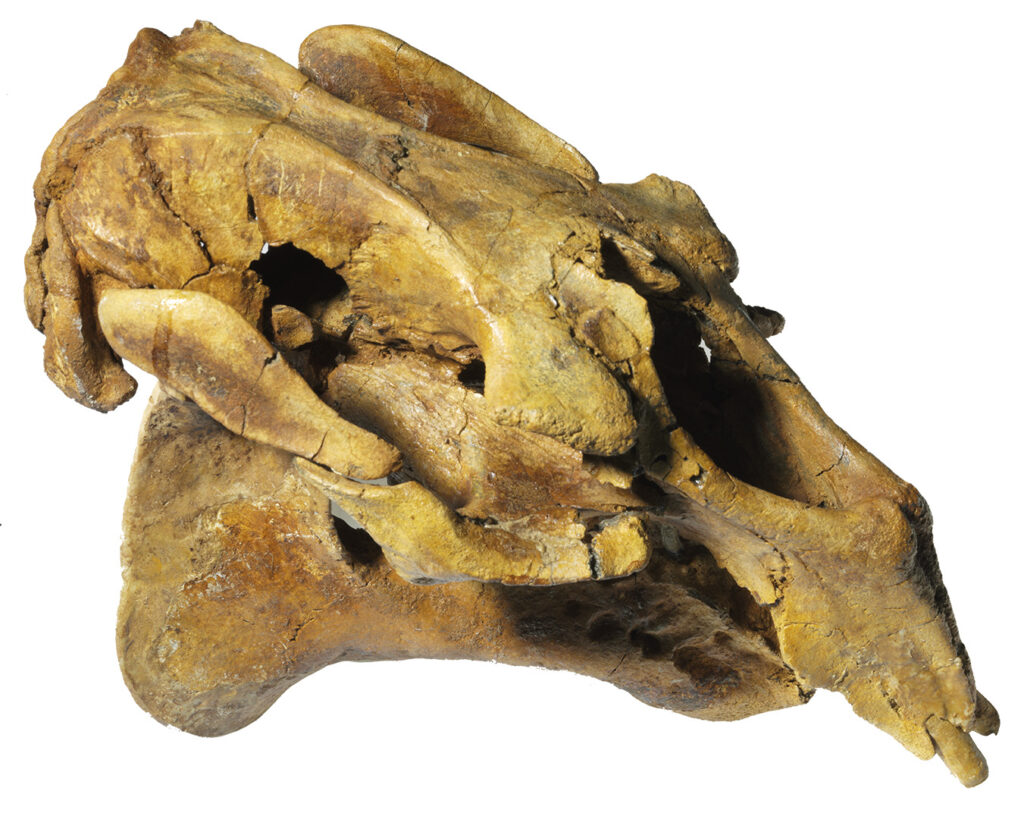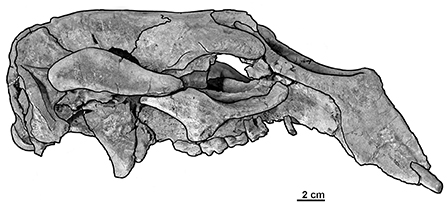November 2024: Sea cow
Kaupitherium gruelli Voss & Hampe 2017
Skull
Palaeogene: Lower Oligocene: Alzey Formation, approx. 30 million years old
Eckelsheim, Mainz Basin (Rhineland-Palatinate, Germany)
Length 330 mm, width 160 mm, height 190 mm

Sea cows (scientifically: Sirenia) are mammals whose bodies are adapted to a life in the water. They no longer have hind legs and their front extremities have been transformed into flippers. The torso is barrel-shaped and the neck is short. The tail has a strong horizontal fin at the end. The sirenian’s habitat is the coastal areas of the Atlantic, Indian and Pacific Oceans as well as the rivers of the South American Amazon basin and West Africa. They are the only aquatic living mammals in the modern world that feed exclusively on plants. Thanks to fossils and molecular biology, we know that their closest living relatives are elephants. The similarity with whales is not due to a common ancestor, but has evolved independently and is based solely on adaptation to the same habitat, This is an excellent example of a biological analogy.
The rich fossil record provides an exciting insight into the gradual transformation of sirenians from terrestrial to aquatic animals and their former distribution areas in North America and Europe. The oldest sirenians known to us date from the early Eocene and are over 50 million years old. They still had four limbs, were about the size of a pig and liked to spend much time in the water even then. More recent finds include evidence of all important stages of hind leg reduction in the skeleton. Around 35 million years ago, in the late Eocene, sirenians already had a modern appearance.

The fossil of the month is the skull of an almost complete skeleton of one of the first advanced sirenians. The skull is so exceptionally well preserved that it has been established as a reference specimen for the species Kaupitherium gruelli. It shows the typical sirenian anatomy with the strongly enlarged and downwardly curved premaxillary bone, the large, backwards displaced outer nasal opening and the prominent zygomatic arches. The premaxillary bone bears two tusk-shaped incisors.
The skeleton was recovered in the first half of the last century from the sands of the Alzey Formation near Eckelsheim in the Mainz Basin southwest of Mainz (Rhineland-Palatinate). This sea cow probably died there during a storm around 30 million years ago. At that time, there was no solid land mass in the area of today’s Central Europe, but a subtropical archipelago characterized by inlets and embayments, which formed an ideal habitat for sirenians that lived in warm shallow waters. Accordingly, sirenian fossils are frequently found in the rocks from this period.
The skeleton was acquired by the Bavarian State Collection in 1956.
Gertrud E. Rössner, (München),
Manja Voss (Museum für Naturkunde, Berlin),
Oliver Hampe (Museum für Naturkunde, Berlin)



